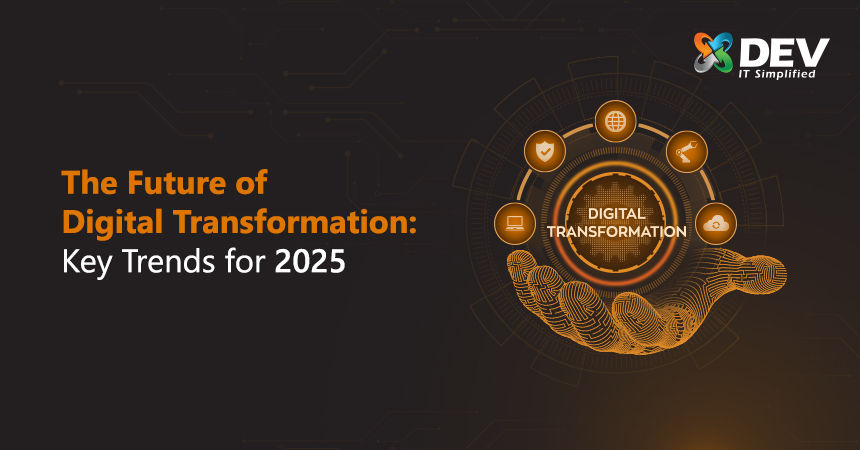The Future of Digital Transformation: Key Trends for 2025
- iamdevpatel58
- Sep 18
- 4 min read

As we move into 2025, the pace of digital change is faster than ever. Businesses across the globe are accelerating their adoption of digital transformation services to stay competitive amid a wave of emerging technologies. What’s driving this shift? A powerful mix of emerging technologies like artificial intelligence (AI), automation, and cloud computing are changing how companies think, work, and deliver value. These trends are not just tech buzzwords. Infact, they are redefining entire business models.
And to stay ahead, organizations need more than just tech upgrades; they need smart, strategic solutions that are built for the future. In this blog, we will explore the key technology trends for 2025 and how they are driving enterprise digital transformation. We will also examine the strategic role of Microsoft’s ecosystem including Microsoft Power Platform, Microsoft Azure AI, and Copilot in enabling organizations to implement transformation effectively. Whether you’re just starting your transformation journey or looking to refine your approach, this guide offers a blueprint for staying ahead in a tech-driven world.
AI & Data Analytics Take the Centre Stage
AI has moved from a back-office experiment to a centerpiece of business strategy. Today, AI and data analytics are being woven into daily workflows, helping teams turn raw data into real-time insights and smarter decisions. In fact, recent reports show that generative AI adoption has surged, with 75% of business leaders now using it in some form, a big leap from last year.
What’s fueling this growth? It’s the rise of powerful AI models – from large language models to task-specific machine learning systems that help predict customer needs, personalize experiences, and streamline operations. A great example of this in action is Microsoft Copilot. From summarizing meetings to drafting emails, Copilot is already used by 70% of Fortune 500 companies, saving employees time on routine tasks and boosting productivity.
And this is just the beginning. We are now seeing AI-powered agents evolve into true digital co-workers, capable of handling more complex, cross-functional workflows. From predictive maintenance in manufacturing to real-time financial forecasting in banking, businesses that embed AI and data analytics into their core strategy are opening up new, data-driven business models.
The engine behind much of this innovation? Cloud-based platforms like Microsoft Azure AI. With ready-to-use models and custom AI tools, Azure makes it easier for organizations, both big and small to tap into advanced AI without needing an entire data science team. Services like Azure OpenAI and Azure Machine Learning offer everything from natural language processing to predictive modeling, enabling companies to build intelligent solutions faster and more efficiently.
Automation & Low-Code: Driving the Next Productivity Shift
Automation is no longer a “nice to have”—it’s a must-have for any organization serious about modernizing its operations. In 2025, we are seeing hyperautomation take center stage, combining AI, robotic process automation (RPA), and workflow tools to eliminate repetitive tasks and improve consistency across the board. One of the biggest drivers of this trend is the rise of low-code and no-code platforms, which are making it easier for business users and not just developers to build solutions. Gartner estimates that 70% of new enterprise apps will be created this way by 2025. This shift is empowering everyone from HR to finance to automate routine tasks without waiting on IT.
Enter Microsoft Power Platform—a suite of low-code tools (Power Automate, Power Apps, Power BI, and Power Virtual Agents) that lets users build apps, automate workflows, and create dashboards with ease. For example, a finance team can use Power Automate Solutions to automatically capture invoices from emails, send them for approval, and update records—no manual entry, no delays.
The beauty of platforms like Power Platform is their simplicity. You don’t need to be a coder to use them, and that opens the door for more innovation at every level of the business. More importantly, when automation is aligned with a clear business strategy and supported by digital transformation consulting partners, it can dramatically boost efficiency, employee engagement, and ROI.
Cloud: The Backbone of Digital Business
Behind every successful AI or automation initiative, there is a strong cloud foundation. As digital transformation accelerates, cloud computing continues to be the bedrock on which everything else is built. And it’s evolving. In 2025, we are seeing increased adoption of multi-cloud and edge computing strategies, helping companies process data closer to where it is generated and act faster. According to Gartner, half of all enterprise data will be created outside traditional cloud or data center environments by 2025. That’s a huge shift and cloud platforms need to adapt. Microsoft Azure is already leading the way with hybrid and edge-ready services that combine flexibility, scale, and security.
Whether you are building AI models, running analytics, or launching new business applications, Azure offers a unified platform to do it all. Its global infrastructure, combined with tools like Azure AI, IoT, and Azure Synapse, allows companies to experiment, scale, and innovate without being bogged down by legacy systems or capacity constraints.
Cloud is also the foundation for Microsoft’s business applications like Dynamics 365 which help manage CRM, ERP, supply chain, and more. These solutions are built to work seamlessly with Power Platform and Azure, creating an interconnected system where data, workflows, and insights flow effortlessly. Moreover, the integration of cloud computing with automation tools like Power Automate and Power Apps further amplifies transformation Read More: The Future of Digital Transformation







Comments